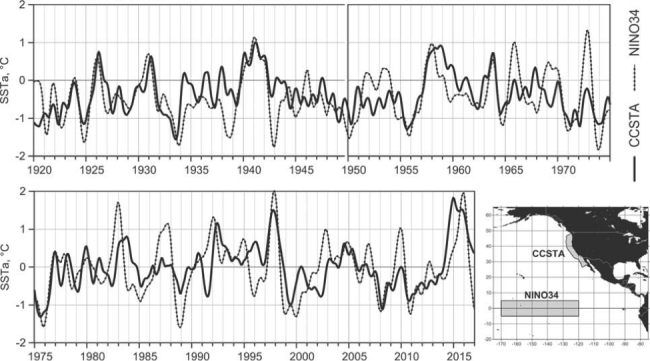The complex relationship between El Niño and the California Current System
Climate scientists have known for decades that warm periods in the California Current System (CCS) can in part be blamed on tropical El Niño events. But there have been lingering questions about the relative importance of El Niño (and the Southern Oscillation, or ENSO) versus local forcing of unusually warm and cold periods in this variable and biologically productive ocean region along the west coast of the continental US and Baja California, Mexico. In a new study, Fiedler and Mantua show that tropical ENSO and local atmospheric forcing of the CCS are only modestly correlated with each other in the period from 1950-2016. Obvious matches or mismatches of warm events in the two regions are apparent in the figure. For example, the record-breaking 1997–98 El Niño coincided with a 1.58°C warming of the CCS. On the other hand, the CCS was not anomalously warm during the 1986–87 El Niño, and the CCS was warm in 1995–96 when the equatorial Pacific (NINO34) was cold. The phasing of warm events in the two regions is also variable, with some warm extremes in phase (1940–42, 1997–98), some with the tropics leading the CCS (1982–83, 1991–92), and the most recent warm extreme from 2014–16 where the CCS warming peaked about one year prior to the peak tropical El Niño warming.

Fiedler and Mantua update the record of warm and cool events in the CCS for 1950-2016 and use sea level pressure and surface wind data to explore the atmospheric forcing of these events. They find that about half of the warm or cool events in either the CCS or tropical waters occur without a corresponding event in the other location. They show that CCS warm events are associated with a strong and southeastward displacement of the wintertime Aleutian Low, a weak North Pacific High, and a regional pattern of poleward coastal wind anomalies. Regional North Pacific forcing is predominant in sea surface temperature variations throughout most of the CCS, while remote tropical forcing related to ENSO is more important in the far southern portion, off the west coast of Baja California. They also found that CCS cool events tend to be more closely associated with tropical La Niña than are warm events with El Niño; the forcing of co-occurring cool events is analogous, but nearly opposite, to that of warm events. Understanding variations between years in the CCS may help predict and manage changes in fisheries and climate of the region.
How are warm and cool years in the California Current related to ENSO? (Journal of Geophysical Research-Oceans)
NOAA Southwest Fisheries Science Center
Topics
- Pacific Ocean
- Ocean Heat
- Ecosystem Impacts
- ENSO
